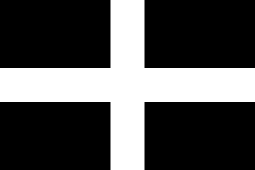Montol Festival
The Montol Festival is an annual festival in Penzance, Cornwall, UK, held on the 21st of December each year since 2007. The festival is a revival or reinterpretation of many of the traditional Cornish midwinter customs & Christmas traditions formerly practiced in and around the Penzance area and common to much of Cornwall at one point. Montol is held on the traditional date of the feast of St Thomas the Apostle, usually the 21st of December, which always coincides with the winter solstice.
Origin of the word Montol
Edward Lhuyd, in his 1700 MSS of vocabulary in the Cornish language, states that Montol means 'winter solstice'.[1] However, he later translates the word as 'balance' (in Latin, Trutina – 'a set of scales'[2]).
Revived customs

At the very core of the festival are several of the revived customs of the West Cornwall area including, predominantly, Guise dancing, the masked celebrations common to Cornwall in the 19th century, the Cornish candle dance (Dons Cantol) in revived Cornish and the performance of traditional Guisers plays such as St George and the Turkish Knight or Buffy and the Bucca. Cornish Christmas carols also feature during the festivities. The "Chalking of the Mock", a Cornish Yule Log custom usually found in pubs or homes on Christmas Eve, is part of the climax of the celebrations, usually happening at 10pm near the dock area of the town.
Historical basis for revived customs
The historical basis for many of the customs described above is taken from the texts of notable Cornish antiquarians and contemporary research into the subject. A. K. Hamilton Jenkin in his book Cornish Homes and Customs[3] describes the Guise dance processions and performances of 1831 as "like an Italian carnival" and further noted that "everyone including the rich and the great came masked and disguised on to the streets". However, he does not give a reference for this quote.
A detailed description of the Penzance Guise dancers is given by William Bottrell in his book Traditions and Hearthside Stories of West Cornwall (1870–80):
During the early part of the last century the costume of the guise dancers often consisted of such antique finery as would now raise envy in the heart of a collector. The chief glory of the men lay in their cocked hats which were surmounted with plumes and decked with streamers and ribbons. The girls were no less magnificently attired with steeple crowned hats, stiff bodied gowns, bag skirts or trains and ruffles hanging from their elbows.
Montol Eve
The main event of the festival is Montol Eve, on the 21st of December every year. During the evening large Guiser processions can be seen through the town, carrying lanterns, wearing masks and traditional costumes. Early in the evening a Lord of Misrule is chosen from among the masked revellers.[4] The Lord of Misrule leads the main processions and has certain honorary functions, although there is no historical basis for this part of the event prior to 2007; there are no historical references to a Lord of Misrule in Penzance or Cornwall. A number of other "Mock leader" customs can also be seen during the evening, including the "Master of the Corn-Market" followed by the Corn-Market revellers. These groups take their inspiration from descriptions of the similarly named groups early in the 19th century.
Later on the appearance of the "Montol Oss" occurs in several locations throughout the town, culminating in the ceremony of the chalking of the Mock. The Mock is the Cornish Yule Log; a member of the public is chosen to mark the Mock with a stick man. In tradition, this represents either the Christ Child or Old Father Time marking the death of the year, or the celebration of the birth of Christ, "the light of the world". Some suggest that this very old Cornish imagery may have some connection to the sacrificial nature of the Roman Saturnalia; the likelihood of this is open to question. A great deal of Cornish dance and music is performed during the evening, often in an improvised and impromptu manner.[5] The symbols of the festival are the spear and square of St Thomas, and the "Sun Resplendent", a traditional image used by Guise dancers.
Community events
During the festival there are a series of workshops dedicated to the making of lanterns and costumes which are used in a large public parade on 21 December in Penzance Town Centre, followed by the lighting of the midwinter fire (the location of which depends on the year in question).
See also
External links
References
- Teer Ha Tavas - Late/Modern Cornish Website Christmas special
- Edward Lhuyd: online transcript of 'Archaeologia Britannica'. National Library of Wales
- Hamilton Jenkin, Alfred Kenneth (1934). Cornish Homes and Customs. London: J. M. Dent. p. 178.
- Montol Official Website
- Simon Reed, The Cornish Traditional Year, Troy Books 2009
